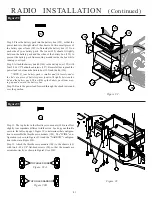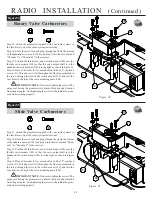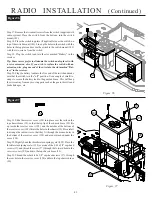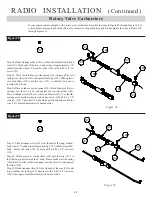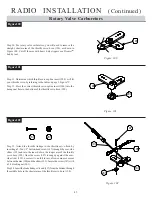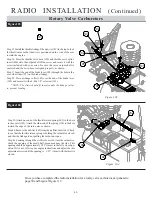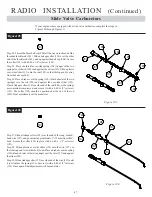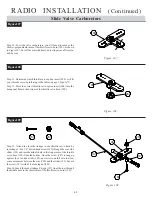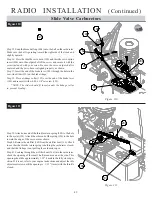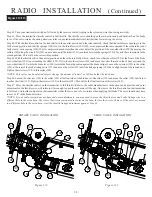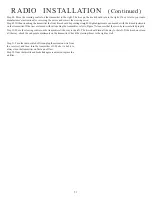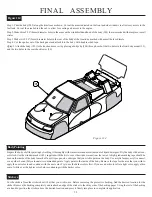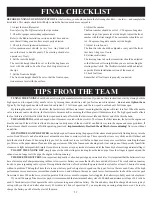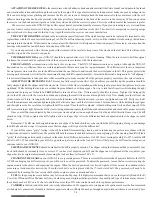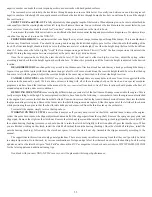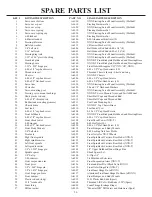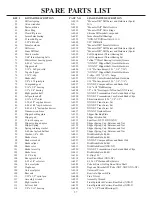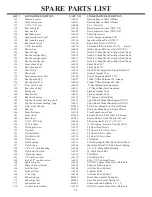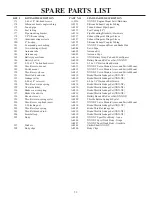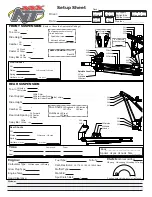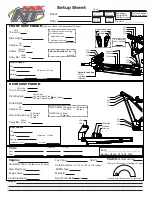
5 5
negative camber can make the truck respond quicker on some tracks with hard packed surfaces.
The rear camber is used to help the truck drive through bumps in corners a little better. Generally, run between one and two degrees of
negative camber at ride height. More negative camber will make the truck drive through bumps better, but you will usually lose a little straight
line rear traction.
FRONT TOE-IN and TOE-OUT
is fully adjustable by changing the length of the tie rods. When adjusting toe-in, be sure to adjust both tie
rods equally so that the steering balance from left to right will remain the same. Toe-out will make the truck turn into the corner faster, but can
cause oversteer. It can also make the truck feel “wandery” exiting corners and cause the truck to hook.
Toe-in makes the truck a little easier to drive, and will make the truck more neutral feeling and more stable exiting corners. We almost always
run about one degree of toe-in on the XXX-NT.
FRONT RIDE HEIGHT
is an adjustment that can change the way a truck jumps, turns and goes through the bumps. This is an adjustment
that can vary from track to track. You should try raising and lowering the front ride height to get a feel for what it does to the handling of the
truck. The front ride height should initially be set so that the arms are level at ride height. To set the ride height, drop the front of the truck from
about 2-3 inches above the table. Lightly "work" the front suspension up and down. This will "settle" the front suspension at its natural ride
height. Working the suspension becomes important as the parts start to get dirty and worn.
Once the suspension has settled, the arms should be level. If the front end is either too high, or too low, adjust the spring collars
accordingly and check the ride height again as described above. Continue this procedure until the front ride height is adjusted to the desired
location.
REAR RIDE HEIGHT
can change the way a truck turns, the amount of traction a truck has and the way a truck goes through the bumps.
Again, it is a good idea to play with this adjustment and get a feel for it. For most conditions, the rear ride height should be set so that the dog
bones are level with the ground. Adjust the rear ride height in the same way as described in the front ride height section.
CAMBER LOCATIONS
on the XXX-NT are very adjustable. Although there are many holes to choose from, it is suggested that the
locations in the manual be used. We have done extensive testing with all of these locations both on the track, and on special computer
programs, and have found the locations in the manual to be
very consistent
from track to track. These locations should produce the best all
around setup and work under most conditions.
REMOVING THE ENGINE
can seem slightly difficult when you look at all of the fuel lines and linkages connected to the engine. This is
really a simple thing to do though. The easiest procedure that we have found is the following — remember to leave the engine mounts attached
to the engine: First, remove the fuel line from the fuel tank. You want to remove the line that runs to the carburetor. Remove the screw that holds
the pipe-mounting wire in place. Remove the four screws that hold the engine mounts in place. Slide the engine out of the left side of the chassis
while positioning the engine so that the short throttle linkage can be removed from the throttle arm on the carburetor.
To reinstall the engine, simply reverse the steps above.
WORKING ON THE CLUTCH
is easier than it may seem. If you only need to work on the clutch, and don't need to remove the engine,
follow this procedure: remove the slipper adjustment nut and all of the slipper parts from the top shaft. Remove the spur gear, gear plate, and
slipper pad. Remove the clip from the clutch nut. Remove the clutch nut spacer and the outside bearing (or bushing) from the clutch bell. With
the outside bearing (bushing) removed you should be able to rotate the clutch bell slightly so that it can slide off, past the throttle servo. When
you are finished working on the clutch, install the clutch bell without the outside bearing (bushing). Once the clutch bell is in place, install the
outside bearing (bushing), followed by the clutch nut spacer. Attach the clutch nut clip. Assemble the slipper assembly according to the
manual.
The suggestions in this section are only general guidelines. There are so many variables in a racing truck that they can’t possibly be listed
in a simple tip section. Go to the track, try various combinations of setups, and get a feel for what each one does to the handling. Look for setup
updates as well as the latest hot tips in "Tech-Talk" each month in
R/C Car
magazine. Also check out our website, WWW.TEAMLOSI.COM
for the latest updates and additional tuning tips.
Good luck with your new XXX-NT. We’re sure you will be pleased with its superb performance.

